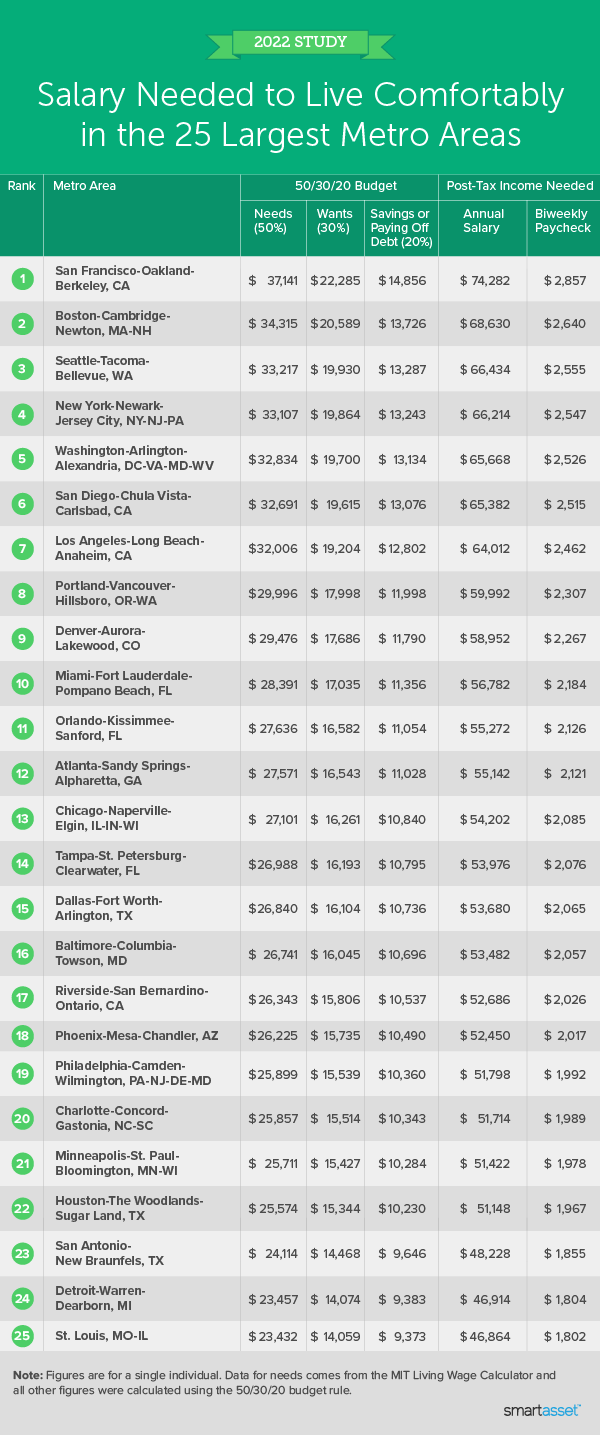Salary Needed to Live Comfortably in the 25 Largest Metro Areas – 2022 Study
In a 2021 modern wealth survey, Americans told Charles Scwab that they need an average net worth of $934,000 to be financially comfortable. Another survey by Personal Capital says that Americans believe that they need to save an average of $516,000 to maintain financial health. The huge difference in these figures indicates that financial comfort is ultimately a relative figure and depends on one's household size, life stage and other personal factors.
For working individuals, however, the threshold for financial comfort in terms of salary may be easier to determine. In this study, SmartAsset analyzed data to identify how much Americans need to earn to live comfortably in the 25 largest metropolitan areas in the U.S.
Data and Methodology
To find how much money is needed to live comfortably in different parts of the country, SmartAsset used the 50/30/20 rule to define that comfort level. This rule is a budgeting strategy that allocates 50% of after-tax income to basic living expenses (needs), 30% to discretionary spending (wants) and 20% for savings or debt payments.
For the study, SmartAsset used the MIT Living Wage Calculator to gather the basic cost of living for an individual in each metro area. The online tool calculates the cost of living by adding together the average cost of housing, food, transportation, medical care and other expenses within each metro area.
We assumed the MIT cost of living figure for each metro area would cover needs (i.e. 50% of one's budget) and then calculated the total take-home pay that enables individuals to spend an additional 30% on wants and 20% on saving/paying off debt.
Key Findings
Metro areas on the coast require the highest salaries. Unsurprisingly, metro areas along the East and West coasts demand the most after-tax income to live comfortably, with nine out of the top 10 places located on the eastern and western seaboards. Greater Denver is the only metro area not located on either coast that appears in the top 10.
Financial comfort is most affordable in St. Louis. The greater St. Louis metro area in Missouri and Illinois requires an annual post-tax salary of just $46,864 (or biweekly paychecks of $1,802) to live comfortably. This is almost 37% lower than the salary ($74,282) Californians need to live comfortably in the San Francisco-Oakland-Berkeley metro area, which is ranked as the most expensive in our study.
The average salary needed to live comfortably across the 25 largest U.S. metro areas is $57,013. It takes at least $2,193 in biweekly paychecks after taxes ($57,013 in annual after-tax income) to live comfortably across the 25 largest metro areas in the U.S.
Five Places That Require the Highest Salaries
1. San Francisco-Oakland-Berkeley, CA
To live comfortably in the San Francisco-Oakland-Berkeley metro area, an individual needs to earn at least $74,282 after taxes, making it the most expensive of the nation's 25 largest metro areas. According to the MIT Cost of Living Calculator, a single person in the San Francisco-Oakland-Berkeley area spends a minimum of $37,141 on living expenses annually. Using the 50/30/20 budget, a person living comfortably in this part of California would allocate another $22,285 for discretionary spending and $14,856 on savings and debt paydown.
2. Boston-Cambridge-Newton, MA-NH
The Boston-Cambridge-Newton metro area, which extends into New Hampshire, requires the second-highest after-tax income ($68,630) to live comfortably. Living expenses for an individual in this New England population hub add up to $34,315. As a result, a single person would allocate 30% of their take-home pay ($20,589) for discretionary spending and $13,726 for savings and debt payments.
3. Seattle-Tacoma-Bellevue, WA
Average living expenses in the Seattle-Tacoma-Bellevue metro area in Washington total $33,217 per year, according to MIT calculations. This means a single person needs to make at least $66,434 after taxes to live comfortably. After their basic living expenses are covered, an individual could spend $19,930 on wants and set $13,287 aside for savings or debt paydown.
4. New York-Newark-Jersey City, NY-NJ-PA
In the nation's largest metropolitan area, a person needs a biweekly take-home pay of at least $2,547 to live comfortably. That's because basic living expenses in the New York-Newark-Jersey City metro area of New York, New Jersey and Pennsylvania add up to $33,107 per year. A person can live comfortably with an after-tax income of $66,214, spending $19,864 on discretionary expenses and using the remaining $13,243 to bolster their savings or pay off debt.
5. Washington-Arlington-Alexandria, DC-VA-MD-WV
The metropolitan area that surrounds Washington D.C. requires the fifth-highest take-home pay for a person to live comfortably. Your biweekly take-home pay needs to be at least $2,526 in order to cover basic expenses and have enough leftover for discretionary spending, saving and debt payments. Using the 50/30/20 budget, a person living in the Washington-Arlington-Alexandria area would need to earn $65,668 annually after taxes. While $32,834 would pay for living expenses, discretionary spending amounts to $19,700 annually and the remaining $13,134 would be allocated to savings or debt paydown.
Pros and Cons of the 50/30/20 Rule Budget
The 50/30/20 rule budget is a simple and easy-to-follow strategy for personal finance. Sandy Yong, author of "The Money Master," said the 50/30/20 rule budget allows you to live comfortably, while also being able to buy items you want and work toward future savings goals.
"It's structured in a way where it encourages you to be mindful of your spending habits and helps you assess how you can still live comfortably and find some cost savings. It's a good guideline to follow, but if you stray from it a bit it's okay," Yong said.
Robert R. Johnson, a chartered financial analyst (CFA) and professor of finance at Creighton University, said the strategy can help make savings a priority. However, it can also encourage people to increase their spending as their salary rises.
"One of the drawbacks of 50/30/20 budgeting is that it encourages people to let their spending increase commensurate with their salary. When one advances in terms of earning power, one can afford to devote more than 20% of salary into that third bucket," said Johnson, who also holds the chartered alternative investment analyst (CAIA) certification. "People are wise to effectively invest any money from a raise and to act as if you didn't receive the raise. That is, continue to live the same lifestyle you led before receiving a raise and invest the difference."
While low-income earners may not be able to allocate the full 20% to savings or keep their basic cost of living under the 50% threshold, the strategy also may not fit the needs of high-income earners.
"Your spending on necessities may be a very high percentage of your take-home pay if you are low-income and a minimal percentage of your net income if you are high-income," said Laura Lonie, a certified public accountant (CPA) and financial coach in Buffalo, New York. "Also, if you live in a very high cost-of-living area, your necessities will be higher due to higher housing costs, etc."
For people seeking an alternative budget, experts point to the pay-yourself-first method, which requires allocating a certain percentage of every paycheck for savings and/or debt payment. The rest can be used to pay bills and discretionary spending.
The envelope system is another popular budgeting technique that involves putting physical cash in envelopes designated for particular purposes. "You only put enough cash in each categorized envelope (gas, rent, etc.) and bring it with you when you're shopping," said Anthony Martin, founder and CEO of Choice Mutual, a life insurance company.
"This can be more advantageous for those who tend to overspend on things you don't necessarily need," he said.
Tips to Get Your Budget in Order
Work with a financial planner. Certified financial planners (CFPs) are financial advisors who specialize in creating holistic financial plans for clients. A CFP can help you create a budget that aligns with your financial goals. SmartAsset's free tool matches you with up to three financial advisors who serve your area, and you can interview your advisor matches at no cost to decide which one is right for you. If you're ready to find an advisor who can help you achieve your financial goals, get started now.
Beware of the lifestyle creep. It's understandable that your spending would increase as your salary grows throughout your career. This is known as lifestyle creep and it can undercut your ability to scale your wealth. One way to avoid this gradual uptick in spending is to effectively ignore salary bumps. When you receive a raise, fight the urge to increase your monthly budget. If you can, keep your budget the same and simply save or invest the extra money.
Treat your savings like your mortgage. If you're struggling to save money each month, try thinking of monthly savings like your mortgage or rent payments. Housing is an essential need that we all require, so making your monthly savings a similar non-negotiable component of your budget may help. Set aside a specific amount of money from every paycheck and have it automatically deposited into a savings account.
Questions about our study? Contact press@smartasset.com.
Photo credit: ©iStock.com/Moyo Studio
The post Salary Needed to Live Comfortably in the 25 Largest Metro Areas – 2022 Study appeared first on SmartAsset Blog.

 Yahoo Sports
Yahoo Sports 

